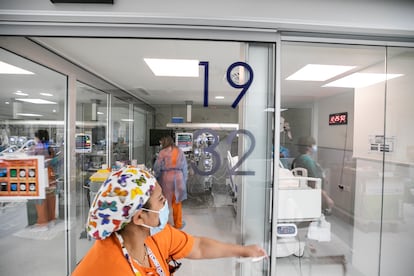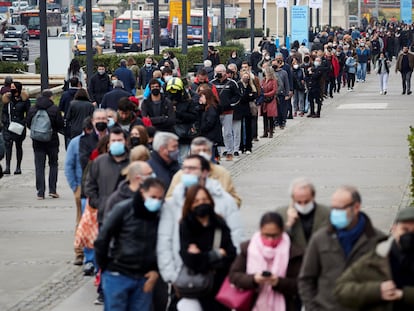BA.2: A new version of the omicron coronavirus variant that is even more contagious but not more serious, according to early data
Provisional analysis from Denmark suggests this subtype of SARS-CoV-2 is 1.5 times more transmissible, but there is no indication that it is evading the protection offered by vaccines

The omicron variant of the coronavirus was already the fastest-spreading virus in history, but a subvariant named BA.2 could be even more transmissible than the version observed until now, which was known as BA.1. One of the countries that is observing mutations of the coronavirus closest, Denmark, has detected explosive growth of BA.2 to the point where it became dominant in just a few weeks. Preliminary data from Denmark suggest that BA.2 is 1.5 times more contagious than the classic subtype of omicron, according to results published last Wednesday by the country’s authorities. The good news is that vaccination continues to be highly efficient when it comes to avoiding serious cases of Covid-19, whatever variant it might be. Denmark is registering more cases than ever, but the number of patients in intensive care units (ICUs) is falling.
The team lead by microbiologist Darío García de Viedma, from the Madrid hospital Gregorio Marañón, confirmed on Wednesday two of the first BA.2 cases in Spain, where the presence of this subvariant is still anecdotal. The researcher points to the fact that the two subtypes of omicron differ more between themselves than the original virus detected in Wuhan and the alpha variant discovered in England toward the end of 2020. “We are talking about a big difference,” García de Viedma explains. “BA.2 has enough mutations to make close monitoring worthwhile.” There is no evidence to suggest that BA.2 causes more serious illness than its sister.
Some PCR tests look for three genes of the virus to diagnose the infection. The delta variant, which was detected in India and was dominant across the world until the end of 2021, would show up these three genes, but the classic version of omicron only showed up two. This characteristic allowed for the assumption to be made as to whether a person was infected with delta or omicron via a simple PCR test, without the need to sequence the complete genome of the virus. The subvariant BA.2, however, does not have this mutation and is indistinguishable from delta with these specific tests, prompting the name “the stealth variant,” a term that is not popular among many experts, including the virologist María Iglesaisa, from Spain’s National Microbiology Center.
“It has made a lot of noise for something that is supposedly silent,” jokes Iglesias, in reference to the media attention received by BA.2 in recent days. The moniker of “stealth” is very deceptive. A person infected with this subvariant tests positive with no problem in an antigen or PCR test, the only difference is that now it is not so simple to deduce which kind of coronavirus it is in the aforementioned tests that seek these three specific genes.
BA.2 has enough mutations to make it close monitoring worthwhileMicrobiologist Darío García de Viedma
María Iglesias points out that 83% of cases in Spain are caused by the BA.1 subvariant of omicron, the classic strain. The delta variant is behind the other 17%. BA.2 is already being detected, albeit residually, in the Spanish regions of Madrid, Catalonia, Asturias and the Balearic Islands. “We are not seeing the explosion of cases that there has been in Denmark,” the virologist explains. “Obviously the variants need to be monitored, but on a scientific level. This is not to say that each one deserves a front page in all media outlets,” Iglesias argues, given her fears of excessive attention contributing to so-called pandemic fatigue. “We don’t know anything, it’s all speculation. People are starting to get tired and not believe anything,” she warns.
On January 21, the World Health Organization (WHO) called for research into BA.2 to be prioritized, after there was a rise in the proportion of cases in India, South Africa, the United Kingdom and Denmark. In Berlin, around one in every three infections is already due to BA.2. In the world, however, nearly 99% of omicron cases continue to be caused by BA.1, according to the WHO.
Doctor Roger Paredes, from the Germans Trias Hospital in the Spanish city of Badalona, huffs and puffs when imagining the future. “There is no sign that suggests that BA.2 is a more serious variant than its predecessor, but it is true that it could be a bit more transmissible,” he explains. “The consequence of the arrival of BA.2 could be that the end of this wave is delayed, which is what is happening in England: cases were falling and now they have stabilized.” In his area, Paredes explains, only two cases of BA.2 have been detected for now.
Three doses of a Covid-19 vaccine have practically the same efficiency, up to 70%, when it comes to avoiding symptomatic infections with either of the two sub-variants of omicron, according to a report from the UK’s Health Security Agency published on Thursday. The document confirms 95% protection against deaths caused by BA.1, but there is no data on BA.2 for now.
We are not seeing the explosion of cases that there has been in DenmarkMaría Iglesias, viróloga
Roger Paredes takes for granted that the success of vaccination – combined with the fact that omicron is 25% less serious than delta in the same conditions – will imminently lead to a new stage. “The majority of society has reached a situation where they are fed up and are against more restrictions, so we are going to enter a new phase, basically without restrictions,” Paredes predicts. “Fundamentally, what is happening is the pressure is passed on to hospitals. We are likely to have waves with hundreds of patients in ICUs over the coming years. We are going to need good monitoring systems to know when things are getting out of hand,” Paredes warns.
Biologist Iñaki Comas, from the Valencia Biomedicine Institute (CSIC), is calm. “It doesn’t look like the face of the epidemic will change much even if we go from BA.1 to BA.2,” he explains. “In the absence of control measures, such transmissible variants as these will continue to find people who are susceptible to infection, which is going to mean that the fall in cases will probably be slower than in other waves. But we have already learned in the past that the variants can be controlled in the same way: vaccination, ventilation and masks, above all indoors,” Comas adds.
The idea that SARS-CoV-2 is destined to become a more benign version has become generally accepted, but this is not the case, as pointed out by geneticist Emma Hodcroft, from the University of Bern. In fact, omicron did not come from delta, nor did delta come from alpha. “We will see new variants,” she explains. “The important thing is whether these variants will be worrying and will have an impact on the pandemic and on our way of responding. And that we don’t know. Perhaps SARS-CoV-2 has been left without any new tricks that will change its behavior,” she continues. “But perhaps there is another combination that will increase its transmissibility, severity or ability to escape our defenses even more. Unfortunately, there is no way of predicting that. This is why it’s so important to continue investing in the monitoring of the virus,” she concludes.
Tu suscripción se está usando en otro dispositivo
¿Quieres añadir otro usuario a tu suscripción?
Si continúas leyendo en este dispositivo, no se podrá leer en el otro.
FlechaTu suscripción se está usando en otro dispositivo y solo puedes acceder a EL PAÍS desde un dispositivo a la vez.
Si quieres compartir tu cuenta, cambia tu suscripción a la modalidad Premium, así podrás añadir otro usuario. Cada uno accederá con su propia cuenta de email, lo que os permitirá personalizar vuestra experiencia en EL PAÍS.
En el caso de no saber quién está usando tu cuenta, te recomendamos cambiar tu contraseña aquí.
Si decides continuar compartiendo tu cuenta, este mensaje se mostrará en tu dispositivo y en el de la otra persona que está usando tu cuenta de forma indefinida, afectando a tu experiencia de lectura. Puedes consultar aquí los términos y condiciones de la suscripción digital.










































